-
收藏模板下载模板
- 模板信息
- 更新时间:2023-09-08
- 字数:约18101字
- 页数:约17页
- 格式:.doc
- 推荐版本:Office2016及以上版本
- 售价:5 金币 / 会员免费
您可能喜欢的文档

人教版新目标初中英语八年级上册Can you come to my party说课稿5篇
二、教学设计与构思根据以上对教材的分析,同时针对学生学习外语存在一定困难的实际情况及学生的年龄特点,首先给学生营造一个温馨愉悦的氛围,创设一个接近学生生活的语言环境,激发学生的学习兴趣,让学生乐于参于以后的活动中,而且每一个环节都配有相应的动画或亲切的画面,让学生在看、听和感知中接受知识,陶冶情操。最后用清晰明了的方式总结知识要点,便于学生巩固复习。在评价学习上,采用多元化评价,尊重差异,富于感性。布置作业时,分两部分,由浅入深,照顾全体学生。三、教学文法通过五步教学法,精讲巧红,由浅入深,以学生为主体,开展师生双边活动。四、教学手段使用现代化教学手段,多媒体辅助教学贯穿整个教学过程,增加直观性和趣味性,提高教学效果。

人教版新目标初中英语八年级上册How do you get to school教案2篇
Step Ⅶ Role play ( Work on 1b)1. First ask two students to read the dialogue to the class.Sa: How do you get to school?Sb: Well, I ride my bike to the subway station. Then I take the subway.2. Now work with a partner.Suppose you use two kinds of transportation to get to school \Hangzhou\Beijing... (bus, train, subway, walking, bike, etc.) Tell how you get there. You may use the phrases in 1a.3. Then ask different pairs of students to present their conversations to the class.Step ⅧListening1. Work on 2a(1) First ask students to read the list of information that Thomas wants to know.…where Nina lives.…how far from school she lives.…how long it takes to get to school.…how she gets to school.…what she thinks of the transportation.(2) Tell students what transportation and bus stop mean.bus stop 汽车站 transportation n. 运送;运输Then tell students we'll hear a recording. Please put a checkmark in front of each thing that Thomas wants to know.(3) Now play the recording for students.( Have students pay attention to the sample answer.) (4) Then correct the answers.

人教版新目标初中英语八年级下册If you go to the party, you’ll have a great time教案2篇
区分宾语从句、定于从句和状语从句宾语从句和状语从句,都叫做主从复合句。宾语从句主要是中考必考的,是初中阶段必掌握的从句,宾语从句主要是掌握三要素,所谓宾语从句,就是宾语在主从复合句当中充当宾语的一个句子,叫做宾语从句。主句的谓语动词是及物动词,后面如果是词或者是短语的话,是简单句,如果是句子的话,肯定是宾语从句。I know that he good at English.就是宾语从句,三要素,一要素是要注意连词,连词一共学了三类连词,一类连词是that口语当中可以省略,就像刚才说的那一句,I hear he is good at English.还有疑问代词、疑问副词,how where when,疑问代词、疑问副词。还有一类连词weather是否的意思,不是状语从句当中的如果,这一定要和如果区分开,这是是否。I don't know if he interested at English。宾语从句要注意if是连词。第二要素是语序,要用陈述举语序。比如说你家有几口人,我们都说How many people are there in you family?但是这是简单句,一旦说成宾语从句,你可以告诉我你家有几口人吗?Could you tell me how many people there are in you family ?
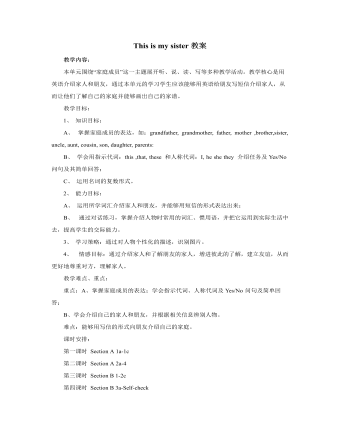
人教版新目标初中英语七年级上册This is my sister教案
(Play the recording twice again.) (Check the answer.) ③Pairwork. Draw your own picture and talk about it. T: We find out the picture of Lin Hai’s family. Can you draw a picture of your family? SS: … T: OK. When you finish drawing, tell your partner about your picture. You can use “This is …” and “ These are …” to talk about. Then report it to the class. (Students work.) (Check students’ work. Ask two or three students to report.) Step Three: Task. Talk about the family tree. T: Look at the family tree. I think it’s a big family. You can do it in groups of four or three. You can do it in pairs or only by yourself. Then report it to the class. (Students work. Teacher walks around in the classroom and helps the students.) T: Stop here. Let’s check it out. (Choose students to do it.) S1: Look at my family tree. This is my… This is my … They have two … This is my … This is my …This is my …This is my. My parents have two children. This is…This is my …My uncle and my aunt have a son. He is my … (Ask two more students to do it.) Homework. Write a passage about your family.
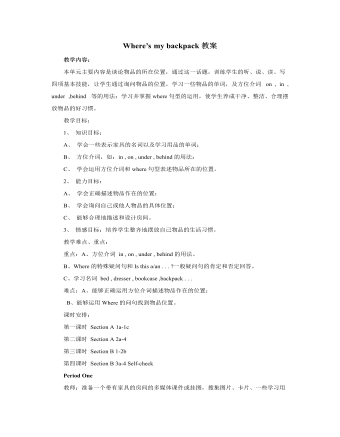
人教版新目标初中英语七年级上册Where’s my backpack教案
教师: 搜集单词卡片、背景资料。 学生:彩笔、大白纸、相关新单词。 教学设计 Step One: Learn the new words. 1.Present the new words. (Show some pictures and words on the screen to teach the students the new words.) T: What’s this? S1: It’s a room. T: Do you have a room like this? S2: Yes, I do./ No, I don’t. T: Read after me. R-O-O-M, room. Ss: R-O-O-M, room. (Teach the other words “TV, desk, picture” in the same way.) T: There are some words here. Read the words after me and spell them. (Learn the other words without pictures on the cards.) T: This is a word. Can you spell this word? (Point to a word in the card.) S1: Yes, I can. / No, I can’t. (Let them know the meaning of “can”.) T: I can spell your name. Can you spell my name? S1: Yes, I can. T: Can you write your name? S: Sorry, I can’t. I have no pen. T: You need a pen.( Give him a pen.) ( Let the students understand the word “need”.) T: I bring a football to school every day. Now it is on the floor. After class I take it to my home. (Teach “bring” and “take”. Put a football on the floor and point to the floor to teach the word “floor”.) 2.Practice the words. (Give the examples to the students and get the students to understand the new words.) Step To Listen and practice.
- 查看更多相关Word文档
Can you come to my party教案3篇
Can you come to my party教案一
I. Analysis of the Teaching Material
1. Status and Function
The topic of this unit is about invitation. It teaches thestudents how to give or receive an invitation. It’s close to the everyday life.So we’d better raise the students learning interest first.

2. Teaching aids and demands
(1) Knowledge Objects
Studentsmust learn to make invitation. They must learn to say yes and say no to aninvitation and give their reasons.
(2) Ability Objects
Toimprove the students’ ability of listening, speaking, reading, writing.
(3) Moral Objects
Weteach this lesson in order to learn how to accept or refuse an invitation offoreign countries politely. It will teach the students good manners. If he orshe holds a party at home, He or she will feel happy when they can do somethingfor others.
(4) Teaching Key Points
Thekey vocabulary and the key phrases of this unit
(5) Teaching Difficulties
Usingthe target language to improve the abilities of the students
II. Target language
Can you come to birthday party?
Yes, I’d love to.
Sorry, I can’t. I have to look after mymother.
When is the party?
It’s at six on Monday.
III. Vocabulary
Tomorrow, weekday, invitation, match, whole,whom, another, concert, pity, free, American,
Chemistry, training…
IV. Learning Strategies
Inducting
Cooperating
V. Teaching procedures.
Itincludes five periods. (5个课时)
The First Period
I. Teaching Aims and Demands
Keyvocabulary and phrases
Targetlanguage
Toimprove the students ability of Listening and speaking
II. Teaching Key Points
(1) Key Phrases
Studyfor a test, have a piano lesson, go to the doctor, visit my aunt
(2) Target language
_Can you come to my party on Sunday?
_Sure, I’d love to.
_Can you come to my party on Sunday?
_Sorry, I have too much homework this weekend.
Ihave to help my mum.
Ihave to go to the doctor.
III. Teaching Difficulties
Using the target language to practice the oralEnglish in pairs
IV. Teaching Methods
Communicative methods
Pairwork
V. Teaching Aids
多媒体
VI. Teaching Procedures
Step 1
Beforethe class, let the students listen to the music, this can guide to the newlesson. After this, ask the
studentsto watch the movie, this can guide to the target language.
Step 2 (1a)
Learnthe phrases and do the exercise in 1a.
Theanswer is: b, d, a, c, e
Step 3 (1b and 1c )
Firstlet the students read the dialogue in the picture. Then listen to it. (Thisactivity provides guided oral practice using the target language). After thelistening practice, ask the student to practice some invitations and refusals.
Step 4 ( culture notes )
Whenyou are in foreign countries, you should know whether an invitation is a realinvitation. If you are invited, but not given a specific time, this is not areal invitation. For example, “Why not have dinner some day?” You mustn’t askwhen you can come. It’s not polite. This is a real invitation: “ Can you cometo my birthday party on Saturday night? When you are asked this way, you shouldonly say: “Yes, I’d love to”. Or “sorry, I can’t. I have to …” and give him orher your reason.
Step 5 (summary and homework)
Todaywe have learnt some key vocabulary and the target language. That is how toinvite somebody and how
torefuse an invitation politely. After class write the phrases in 1a in theexercise book.
Step 6 (Blackboard design)
Unit 5 How about…? polite What about…?impolite |
The second period
ITeaching aims and demands
1.Knowledge Objects
Keyvocabulary
Targetlanguage
Grammarfocus
2.Ability Objects_ Listening
II.Teaching key points
1. key vocabulary
hey,baseball game,too much homework
2. Target language
A:Hey, Dave! Can you come to the movies on Saturday?
B:I’m sorry, I can’t
Ihave too much homework.
Ihave to help my mum.
Ihave to go to my guitar lesson.
Ihave to visit my aunt.
IIITeaching difficulties
Grammarfocus
IVTeaching methods
Listeningand speaking methods.
Communicativeapproach
Pairwork.
VITeaching procedure
Step I
Greetthe class and check the homework
Step II(2a)
First, make the preparation for listening.Read the sentences twice to the class. The first time you can read “can”, thesecond time you can read “can”. Then let the students listen .
Theanswers for activity 2a are : 1. can’t ,2.can3. can’t 4. can’t 5.can
Step III (2b)
Aska student to read the sentences in the box.. Tell the students these are thereason why people can’t go to the party. Listen to the recording again andnumber the reasons 1~3 why they can’t go to the party .
Theanswers are :a . 2d . 3e . 1
Step IV (2c)
Thisis an oral practice about the target the language . You can ask the student ifthey can give other reasons besides the ones in 2a . If they can, make adialogue in pair . ( First , ask two who can do it well to make a modeldialogue , then let them do it in pairs .
Step V . ( Grammar focus)
First, let the students read the sentences in the grammar box . Then write “ have to, has to ” on the blackboard , and tell them they are used to say no to aninvitation . And then write “ be going to do something ” on the blackboard ,tell the students we can say no to an invitation by talking about the futureplan . After that , let them do exercises in order to master to the grammar .
Step V.Blackboard design
Unit 5 1. have to /has to + verb They have to go to the acting lesson on Sunday. Lucy has to help her mom with the housework. Do they have to go to the acting lesson on Sunday. Yes, they do. / No, they don’t. Does Lucy have to help her mom with the housework? Yes, she does. / No, she doesn’t. 2. Can you come to…? Sure, I’d love to. / Sorry, I can’t. I have to… Can she come to…? No, she can’t. She has to… |
Step VI . Homework
Please write as many reasons as you can torefuse an invitation
The Third Period
I Teaching aims and demands
1. Vocabulary and phrasesOral practice
2. Ability objects
Reading, writing, communicative competence
II.Teaching key Points
Reviewvocabulary items and grammar focus
III.Teaching difficulty
Oral practice using the target language
I.Teaching methods
Reading, writing methods and communicativeapproach
V.Teaching procedures
A computer
VI.Teaching procedures
StepI
Greet the class and let a student to make aduty report. And then check the homework
StepII (3a writing)
Show the invitation in 3a to the students. Askthe students to fill in the blanks according to the information of theinvitation.
Theanswers are: can, party, when, on Friday, June 304:30
StepIII (oral practice)
Practicethe dialogue in 3a in pairs and then let some of the act the dialogue.
Step IV (writing)
Letthe students fill in the card with details of an event. Then call your friendsand invite them to the event
.Step V Invite a friend (oral practice)
Tellthe students how to do the activity: Student A, you are Eliza. Look at page 82.Eliza , invite Lu Qing to go to the mall . Look at the calendar for this weekand find a time when you can both go there.
Usethe dialogue in the box to start the activity , and then ask more questions tolearn when both people aren’t busy . Help students to start the work, give thema hand if needed.
Theanswers: Lu Qing and Eliza are both free on Wednesday afternoon , Fridayafternoon , Saturday and Sunday
Step VI. Summary
Today we have learnt how to write aninvitation and done a lot of practice.
Step VII Homework
Give your best friend an invitation to anevent.
The student who receives it must give a reply.
Step III . Blackboard design
Unit 5 1. Lu Qing and Eliza are both Free on :2. have fun /have a great time Wednesday afternoon3. join/take part in Friday afternoon4. have a piano lesson Saturdayhave a swim Sunday have a look |
The Fourth Period
I.Teaching aims and demands.
Targetlanguage
Oralpractice
II.Ability objects.
Listeningskill
Speakingskill
Communicativecompetence
III.Teaching key points
1.Key vocabulary.
Sunday,Monday, Tuesday, Wednesday, Thursday, Friday, Saturday
Yesterday,today, tomorrow, the day after tomorrow
2.Target language.
What’stoday?
It’sMonday the 14th.
Canyou play tennis with me?
When?
Today.
Sorry,I can’t.
IV.Teaching difficulties.
The target language
V.Teaching methods.
Listeningand speaking methods.
VI.Teaching aids.
A calendar
A computer
VII.Teaching procedure.
Step1
Greetthe class and check the homework.
Step2 (Section B 1a)
Showthe students a calendar, and ask a student to point out today’s date. Point tothe number which shows the dates, and ask the students to copy them into thecalendar in their book.
Readthe dates and let the students read after you.
StepIII (1b)
1. Show the words on the screen:
Yesterday,today, tomorrow, the day after tomorrow, weekday
2. Let the students write the words belowthe correct days on the calendar in 1a.
StepIV (1c)
Firstask two students to read the dialogue in the box. Then let them practice it inpairs by using the calendar in 1a.
StepV. (listening 2a)
Firstread the phrases in the box. Ask the students “Can Vince play tennis withAndy?” Circle Yes or No.
Theanswers are: No
StepVI. ( listening2b )
Listenagain, match Vince’s activities with the days. By listening, the students canunderstand the language better.
StepVII. (summary)
Today,we have learnt how to ask the date and how to invite somebody and how to refuseand give a reason.
StepVIII. (homework)
Makea calendar of this month after class.
StepIX Blackboard design
|
The Fifth period
I.Teaching aims and demands.
1.Knowledge objects
E-mailmessage
Writingpractice
Readingpractice
2 Ability objects
Readingand writing skill
Communicativecompetence
II.Teaching key points
Reading passage
主语+verb+-ingI have to…
III.Teaching difficulties
Reading and wring practice.
IV.Teaching methods
Reading and writing methods and communicativeapproach.
V.Teaching aids
Acalendar
VI.Teaching procedures
Step 1
Greet the class, do the duty report.
Step 2 (3a )
First, read the e-mail message to thestudents. Ask the students if they have any questions. If they do, answer them.Then let the students fill in the calendar on the book. After this, explain thekey language points to them.
Language points:
1. Thank you for… (为……表示感谢)
Thank you for helping me.
Thankyou for your invitation.
2 On ( 在某天,在某天的上午、下午或晚上)
I’mgoing to the dentist on Sunday.
OnFriday afternoon, I often play soccer.
The answers to the calendar are:
Sunday |
|
Monday | Cousin’s birthday party |
Tuesday | Go to the dentist |
Wednesday |
|
Thursday | Tennis training |
Friday | Study for the chemistry test |
Saturday | Go to the movies |
Step 3 (3b)
First, tell the studentswhen we talk about our future plans, we often use: I’m+verb+ing When we talk about what we must do, we use have to.
Ask the students to fill in the blanks in 3b.
The answers are:shopping, go to see, a test, I’m going, my family.
Step 4 (3c)
Let the students write an e-mail message to afriend. Say why you can’t visit next.
Before the exercise, ask the students to givesome possible answers and write them on the blackboard. So the students willfeel easy to finish the writing exercise. After they finish it, Let them tocorrect it in groups first. Each group chooses theirs best one to read in frontof the whole class.
Step 5 ( planning a party )
First read the conversation in the boxtogether. Then ask the students to turn to page 88.
Write down everything you have to do nextweek. Write in all the things you have to do .
Ask the students to look at the list. Ask them“What day are you free?” This is when you can have your party.
Step 6 (Self check 1 )
Let the students to fill in the blanks withthe words given. Change the forms of the words if possible. Then make their ownsentences.
The answers are: visit, playing, have to,study, come
Step 7 (Self check 2)
Imagine you are Marie. Read the informationand look at your schedule. Write replies to the invitation.
VII.Summary and homework
Todaywe have learnt how to write a e-mail to a friend. You can write another one toyour frien after class.
Step 8 Blackboard design
Unit 5 1. Thanks for… 2. on Sunday at 4:00 Thanks for helping me. I’m going to the dentist on Sunday. Thanks for your invitation.I often get up at 4:00. |
Can you come to my party教案二
教学目标
本课主要是让学生学习如何礼貌地发出,接受,拒绝邀请。
教学过程
一、课前热身(Warm-up)
教师提问学生周末干的事情。
T: What weekend activities do you know? Make alist.
Ss: Study for a test/ go to a movie /have a pianolesson /surf the internet/ help my mother /visit my grandfather /playbasketball and so on.
接着,教师让学生把所知活动写在黑板上,这样既为下一步要用到活动名提供了选择和参考,又让学生学习以前知识且能体验到成就感,兴趣大增。在列举的基础上,教师补充如Go to the doctor /go to the baseball game/ have aguitar lesson等且写在黑板上。
二、导入(lead-in)
利用媒体资源中课件,播放一个关于如何在party中礼貌地发出,接受,拒绝邀请的短片。
2. 教师接着提问学生:
T; What activities do you want to do this weekend?
S: I want to …
T: What activities do you not want to do?
S: I don’t want to study for a test.
T; Yes, you don’t like these activities but youhave to do them.
教师把句型You have to do something.写在黑板上,这样导入了表示拒绝的重点句型 I have to…然后问学生是否能参加我的生日晚会(晚会时间各不相同,有上课时,周末等)回答中必然有肯定和否定两种,帮助学生回答完整,且把下列对话写在黑板上。
A: Can you come to my party?
B: Sure, I’d love to. Thanks for asking./
Sorry I can’t. I have a piano lesson/have too muchhomework…
I’m sorry, I can’t. I have to help my mother./goto the doctor.
I’m sorry, I can’t. I’m playing soccer./going tothe movies.
这样表示拒绝的三种理由表达法都呈现出来了,下一步学生就会使用以上三种句型来拒绝邀请。
三、教学Section A-1a,1b
1. 教师让学生认真看1a上面的图片,然后叫一名学生读出图片中的对话,让学生熟悉本单元的目标语言。
2. 教师再叫一名学生读出 1a中的短语,让学生将短语和图片匹配。
3. 教师订正答案。
4. 利用媒体资源课件,进行1b部分的教学,并用课件展示答案。
四、教学Section A-1c
1. 此任务是学以致用,利用以上所学来向对方提出或拒绝或接受邀请,这样一来学生在使用目标语中慢慢掌握了本节课重点内容.教师将学生分成四人一组,四人分饰A,B,C和D,进行小组讨论,然后编对话。
2. 提问最后两组学生互相邀请,随后问全班同学Can he /she come to his or her party? Help them toanswer .No he /she can’t. He /She has a football lesson /has to help hermother/is surfing the Internet. 然后让学生以第三人称的口气练习对话。例:
A: Can you go to the movies?
B: Sorry, I can’t. I have to go to the doctor.
C: Can he go to the movies?
A: No he can’t .He has to go the doctor.
说明:通过练习会话,操练和掌握了第三人称的相关内容。
3. 假设马上有一个音乐会,六人为一组,一人邀请其余五人同去,然后汇报邀请结果,这样学中用,用中学既练习如何发出,接受和拒绝邀请,同时练习了用第三人称汇报邀请结果.
五、教学Section A-2a,2b
1. 教师提问学生都有情况导致我们要拒绝别人的邀请。
2. 在学生回答的基础上,教师展示几副相关的图片。
3. 教师让学生阅读2a,2b的题目要求,明确听力任务。
4. 利用课件,播放2a,2b的语音,完成 2a,2b.
5. 教师订正答案,对出现错误较多的题目进行讲解。
说明:在前面部分训练熟练的基础上再做听力 ,既能起到再次训练和巩固的作用,有能让学生体验到成功的喜悦,提高学习兴趣和听力。
转载请注明出处!本文地址:
https://www.lfppt.com/worddetails_20953434.html最新课件教案文档
-

精选高中生期末评语
1、该生学习态度端正 ,能够积极配合老师 ,善于调动课堂气氛。 能够积极完成老师布置的任务。学习劲头足,听课又专注 ,做事更认 真 ,你是同学们学习的榜样。但是,成绩只代表昨天,并不能说明你 明天就一定也很优秀。所以,每个人都应该把成绩当作自己腾飞的起 点。2、 你不爱说话 ,但勤奋好学,诚实可爱;你做事踏实、认真、为 人忠厚 ,是一个品行端正、有上进心、有良好的道德修养的好学生。在学习上,积极、主动,能按时完成老师布置的作业,经过努力 ,各 科成绩都有明显进步,你有较强的思维能力和学习领悟力,学习也有 计划性,但在老师看来,你的潜力还没有完全发挥出来,学习上还要有持久的恒心和顽强的毅力。

公司2024第一季度意识形态工作联席会议总结
一是要把好正确导向。严格落实主体责任,逐条逐项细化任务,层层传导压力。要抓实思想引领,把理论学习贯穿始终,全身心投入主题教育当中;把理论学习、调查研究、推动发展、检视整改等有机融合、一体推进;坚持学思用贯通、知信行统一,努力在以学铸魂、以学增智、以学正风、以学促干方面取得实实在在的成效。更加深刻领会到******主义思想的科学体系、核心要义、实践要求,进一步坚定了理想信念,锤炼了政治品格,增强了工作本领,要自觉运用的创新理论研究新情况、解决新问题,为西北矿业高质量发展作出贡献。二是要加强应急处事能力。认真组织开展好各类理论宣讲和文化活动,发挥好基层ys*t阵地作用,加强分析预警和应对处置能力,提高发现力、研判力、处置力,起到稳定和引导作用。要坚决唱响主旋律,为“打造陕甘片区高质量发展标杆矿井”、建设“七个一流”能源集团和“精优智特”新淄矿营造良好的舆论氛围。三是加强舆情的搜集及应对。加强职工群众热点问题的舆论引导,做好舆情的收集、分析和研判,把握时、度、效,重视网上和网下舆情应对。
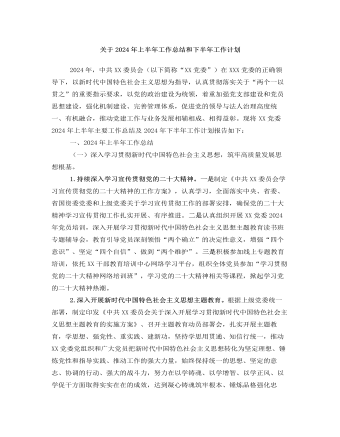
关于2024年上半年工作总结和下半年工作计划
二是深耕意识形态。加强意识形态、网络舆论阵地建设和管理,把握重大时间节点,科学分析研判意识形态领域情况,旗帜鲜明反对和抵制各种错误观点,有效防范处置风险隐患。积极响应和高效落实上级党委的决策部署,确保执行不偏向、不变通、不走样。(二)全面深化党的组织建设,锻造坚强有力的基层党组织。一是提高基层党组织建设力量。压实党建责任,从政治高度检视分析党建工作短板弱项,有针对性提出改进工作的思路和办法。持续优化党建考核评价体系。二是纵深推进基层党建,打造坚强战斗堡垒。创新实施党建工作模式,继续打造党建品牌,抓实“五强五化”党组织创建,广泛开展党员教育学习活动,以实际行动推动党建工作和经营发展目标同向、部署同步、工作同力。三是加强高素质专业化党员队伍管理。配齐配强支部党务工作者,把党务工作岗位作为培养锻炼干部的重要平台。
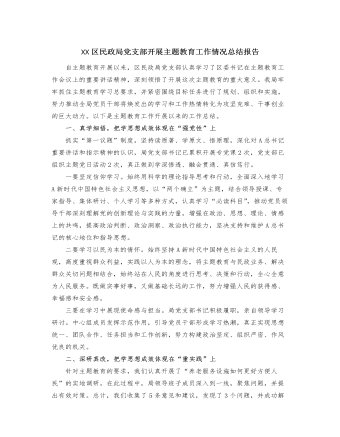
XX区民政局党支部开展主题教育工作情况总结报告
二要专注于解决问题。根据市委促进经济转型的总要求,聚焦“四个经济”和“双中心”的建设,深入了解基层科技工作、学术交流、组织建设等方面的实际情况,全面了解群众的真实需求,解决相关问题,并针对科技工作中存在的问题,采取实际措施,推动问题的实际解决。三要专注于急难愁盼问题。优化“民声热线”,推动解决一系列基层民生问题,努力将“民声热线”打造成主题教育的关键工具和展示平台。目前,“民声热线”已回应了群众的8个政策问题,并成功解决其中7个问题,真正使人民群众感受到了实质性的变化和效果。接下来,我局将继续深入学习主题教育的精神,借鉴其他单位的优秀经验和方法,以更高的要求、更严格的纪律、更实际的措施和更好的成果,不断深化主题教育的实施,展现新的风貌和活力。
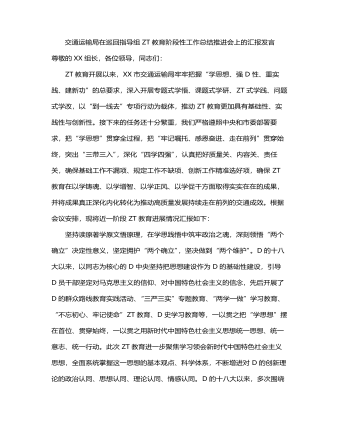
交通运输局在巡回指导组主题教育阶段性工作总结推进会上的汇报发言
今年3月,市政府出台《关于加快打造更具特色的“水运XX”的意见》,提出到2025年,“苏南运河全线达到准二级,实现2000吨级舶全天候畅行”。作为“水运XX”建设首战,谏壁闸一线闸扩容工程开工在即,但项目开工前还有许多实际问题亟需解决。结合“到一线去”专项行动,我们深入到谏壁闸一线,详细了解工程前期进展,实地察看谏壁闸周边环境和舶通航情况,不断完善施工设计方案。牢牢把握高质量发展这个首要任务,在学思践悟中开创建功之业,坚定扛起“走在前、挑大梁、多做贡献”的交通责任,奋力推动交通运输高质量发展持续走在前列。以学促干建新功,关键在推动高质量发展持续走在前列。新时代中国特色社会主义思想着重强调立足新发展阶段、贯彻新发展理念、构建新发展格局,推动高质量发展,提出了新发展阶段我国经济高质量发展要坚持的主线、重大战略目标、工作总基调和方法论等,深刻体现了这一思想的重要实践价值。
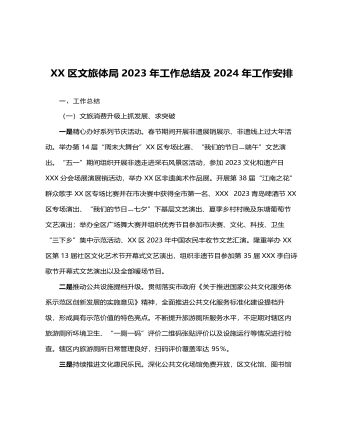
XX区文旅体局2023年工作总结 及2024年工作安排
三、2024年工作计划一是完善基层公共文化服务管理标准化模式,持续在公共文化服务精准化上探索创新,围绕群众需求,不断调整公共文化服务内容和形式,提升群众满意度。推进乡镇(街道)“114861”工程和农村文化“121616”工程,加大已开展活动的上传力度,确保年度目标任务按时保质保量完成。服务“双减”政策,持续做好校外培训机构审批工作,结合我区工作实际和文旅资源优势,进一步丰富我市义务教育阶段学生“双减”后的课外文化生活,推动“双减”政策走深走实。二是结合文旅产业融合发展示范区,全力推进全域旅游示范区创建,严格按照《国家全域旅游示范区验收标准》要求,极推动旅游产品全域布局、旅游要素全域配置、旅游设施全域优化、旅游产业全域覆盖。
今日更新Word
-

精选高中生期末评语
1、该生学习态度端正 ,能够积极配合老师 ,善于调动课堂气氛。 能够积极完成老师布置的任务。学习劲头足,听课又专注 ,做事更认 真 ,你是同学们学习的榜样。但是,成绩只代表昨天,并不能说明你 明天就一定也很优秀。所以,每个人都应该把成绩当作自己腾飞的起 点。2、 你不爱说话 ,但勤奋好学,诚实可爱;你做事踏实、认真、为 人忠厚 ,是一个品行端正、有上进心、有良好的道德修养的好学生。在学习上,积极、主动,能按时完成老师布置的作业,经过努力 ,各 科成绩都有明显进步,你有较强的思维能力和学习领悟力,学习也有 计划性,但在老师看来,你的潜力还没有完全发挥出来,学习上还要有持久的恒心和顽强的毅力。
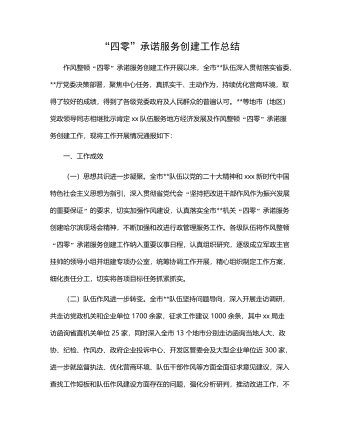
“四零”承诺服务创建工作总结
(二)坚持问题导向,持续改进工作。要继续在提高工作效率和服务质量上下功夫,积极学习借鉴其他部门及xx关于“四零”承诺服务创建工作的先进经验,同时主动查找并着力解决困扰企业和群众办事创业的难点问题。要进一步探索创新,继续优化工作流程,精简审批程序,缩短办事路径,压缩办理时限,深化政务公开,努力为企业当好“保姆”,为群众提供便利,不断适应新时代人民群众对政务服务的新需求。(三)深化内外宣传,树立良好形象。要深入挖掘并及时总结作风整顿“四零”承诺服务创建工作中形成的典型经验做法,进一步强化内部宣传与工作交流,推动全市创建工作质效整体提升。要面向社会和公众庄严承诺并积极践诺,主动接受监督,同时要依托电台、电视台、报纸及微信、微博等各类媒体大力宣传xx队伍作风整顿“四零”承诺服务创建工作成果,不断扩大社会知情面和群众知晓率。

2024年度工作计划汇编(18篇)
1.市政基础设施项目5项,总建设里程2.13km,投资概算2.28亿元。其中,烔炀大道(涉铁)工程施工单位已进场,项目部基本建成,正在办理临时用地、用电及用水等相关工作;中铁佰和佰乐(巢湖)二期10KV外线工程已签订施工合同;黄麓镇健康路、纬四路新建工程均已完成清单初稿编制,亟需黄麓镇完成图审工作和健康路新建工程的前期证件办理;公安学院配套道路项目在黄麓镇完成围墙建设后即可进场施工。2.公益性建设项目6项,总建筑面积15.62万㎡,投资概算10.41亿元。其中,居巢区职业教育中心新建工程、巢湖市世纪新都小学扩建工程已完成施工、监理招标挂网,2月上旬完成全部招标工作;合肥职业技术学院大维修三期已完成招标工作,近期签订施工合同后组织进场施工;半汤疗养院净化和医用气体工程已完成招标工作;半汤疗养院智能化工程因投诉暂时中止;巢湖市中医院(中西医结合医院)新建工程正在按照既定计划推进,预计4月中下旬挂网招标。

驻村工作队2024年第一季度工作总结汇编(4篇)
三是做大做强海产品自主品牌。工作队于xx年指导成立的冬松村海产品合作社,通过与消费帮扶平台合作,在工作队各派出单位、社会团体、个人支持下,已获得逾xx万元销售额。2022年底工作队推动合作社海产品加工点扩建的工作方案已获批,待资金下拨后将正式启动扩建工作。四是积极助企纾困,带动群众增收致富。工作队利用去年建立的xx镇产业发展工作群,收集本地企业在产品销售、技术、人力、资金、运营、用地等方面的需求,并加大xx支持乡村振兴力度,xx助理赴各村委开展多场xx政策支持乡村振兴宣讲活动,本季度有x万元助农贷款获批,xx万贷款正在审批中。在壮大既有产业的同时,完善联农带农机制,一方面鼓励企业雇用本地农户就业,另一方面计划与本地农户签订长期收购合同,让农民种得放心、种得安心,带动当地群众共同致富。

主题教育总结常用提纲大全
第一,主题教育是一次思想作风的深刻洗礼,初心传统进一步得到回归。第二,主题教育是一次沉疴积弊的集中清扫,突出问题进一步得到整治。第三,主题教育是一次强化为民服务的生动实践,赤子之情进一步得到提振。第四,主题教育是一次激发创业担当的有利契机,发展层次进一步得到提升。2.第一,必须提领思想、武装思想。第二,必须聚焦问题、由表及里。第三,必须领导带头、以上率下。第四,必须务实求实、认真较真。3.一是抬高政治站位,坚持大事大抓。二是坚持思想领先,狠抓学习教育。三是突出问题导向,深入整改纠治。四是坚持领导带头,发挥表率作用。4.一是立足“早”字抓筹划。二是着眼“活”字抓学习。三是围绕“统”字抓协调。5.一是形势所需。二是任务所系。三是职责所在。四是制度所定。6.一要提升认识。二要积极作为。三要密切协作。
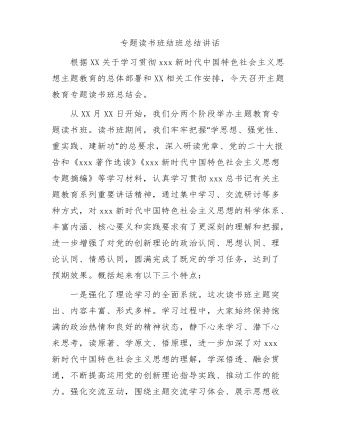
主题教育专题读书班结班总结讲话
第二,要把调查研究贯穿始终,实干担当促进发展。开展好“察实情、出实招”“破难题、促发展”“办实事、解民忧”专项行动,以强化理论学习指导发展实践,以深化调查研究推动解决发展难题。领导班子成员要每人牵头XX个课题开展调查研究,XX月底前召开调研成果交流会,集思广益研究对策措施。各部门、各单位要制定调研计划,通过座谈访谈、问卷调查、统计分析等方式开展调查研究,解决工作实际问题,帮助基层单位和客户解决实际困难。第三,要把检视问题贯穿始终,廉洁奉公树立新风。认真落实公司主题教育整改整治工作方案要求,坚持边学习、边对照、边检视、边整改,对标对表xxx新时代中国特色社会主义思想,深入查摆不足,系统梳理调查研究发现的问题、推动发展遇到的问题、群众反映强烈的问题,结合巡视巡察、审计和内外部监督检查发现的问题,形成问题清单。










